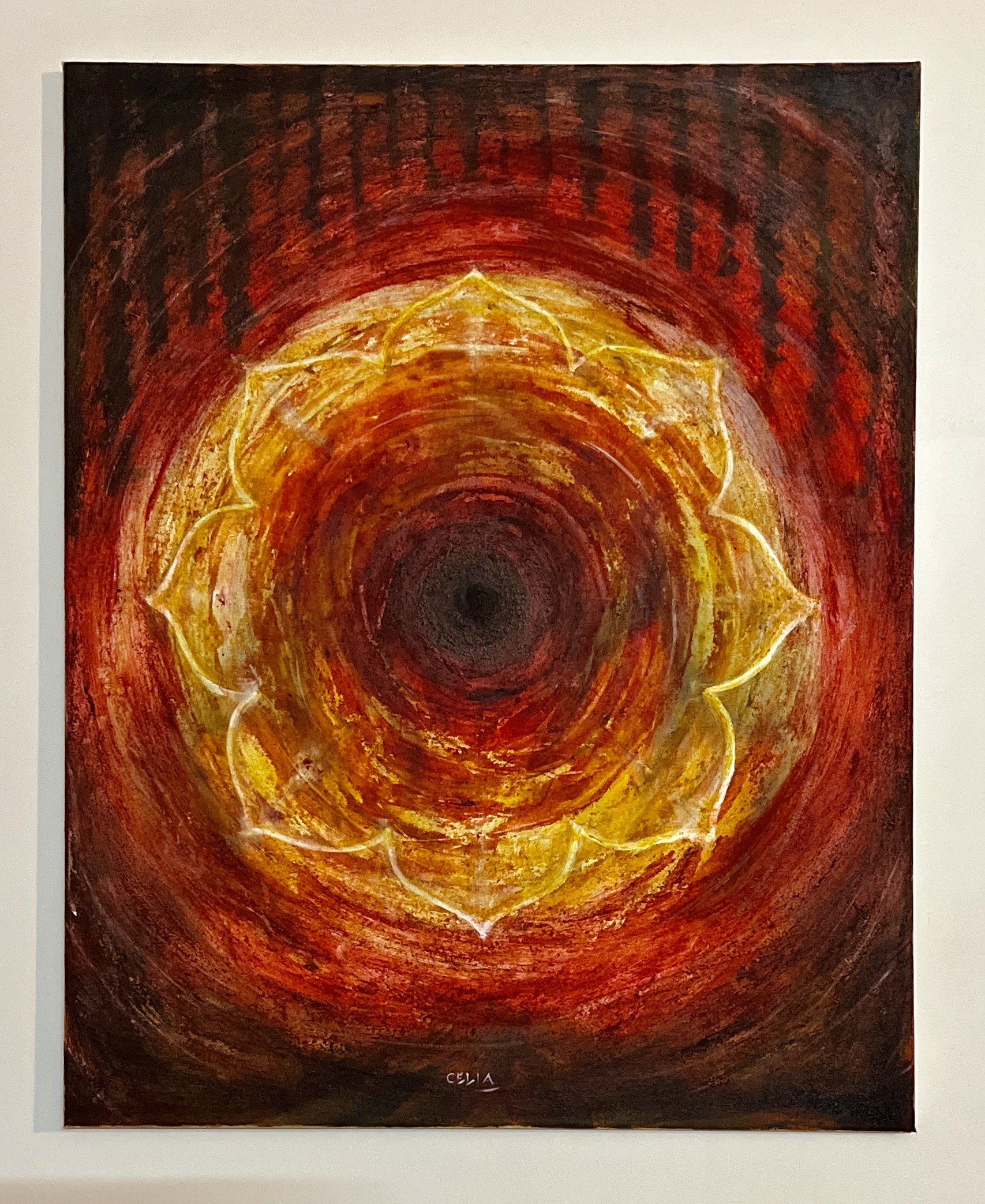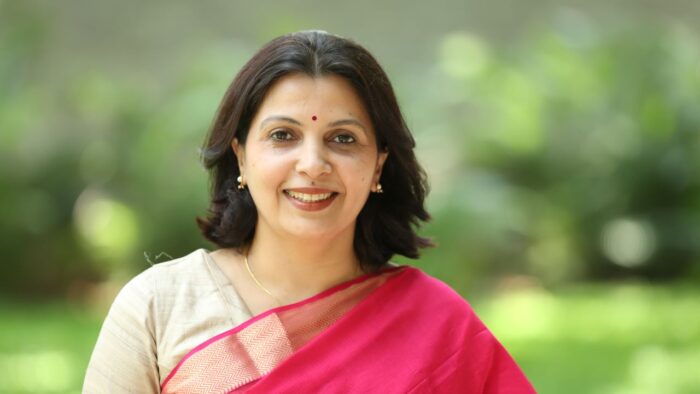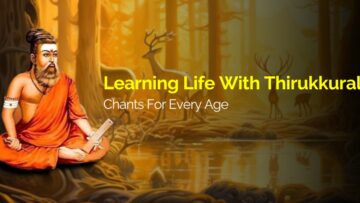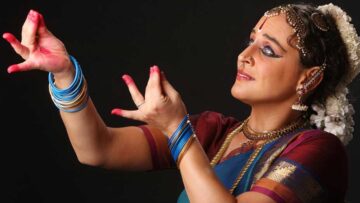The great Indian sage Gargi Vachaknavi was born in the 9th to 7th century BCE, in Northern India, near Mithila. The historical kingdom of Mithila once covered an area that stretched from what is today northern Bihar and Jharkhand states in India and the eastern plains of Nepal. The people who live in this region refer to themselves as the Maithil people and they speak Maithili.
What we know most about the people of Mithila today, is their love for art, something that is also close to Celia Pillai, a ‘strategy and innovation professional’, and author in the Aryaa Anthology. Like the women of Mithila who found agency through their art, Celia in her daily work is an artist and designer. She can relate easily perhaps to the women of Mithila who would paint auspicious symbols on the mud walls of their homes, a skill that was passed on from one generation to another.
Yoga too has been a part of Celia’s life and she has explored the texts as well as the practice. So one can explain her natural attraction to philosopher Gargi, who is mentioned in the 6th and 8th Brahmana of the Brihadaranyaka Upanishad, as she participates in the brahmayajna, a philosophical debate organised by King Janaka of Videha, in whose court she was among the Nava Ratnas. She challenges the sage Yajnavalkya on the nature of Atman. In this interview, Celia speaks about her journey with Gargi.

It’s going to be one year since the publication of Aryaa. How has the reception been by readers? And personally, how do you feel on its completion of one year?
It was only sometime last week that we realized it is going to be a year since Aryaa’s launch. It served as a reminder to reflect on the year gone by. Coincidentally, since I had taken some time off from work over the last few weeks, I had been thinking about the year gone by and reflecting on some changes that I see in myself.
What our readers tell us the most is how surprised they were to learn that women from ancient India were actually such strong characters. This is especially powerful for young women today who grew up thinking they need to look elsewhere to find strong women role models. The ten characters in the anthology provided a range of answers to what defines a “woman of substance”. There is this false notion in many of us that women from our past were powerless, living in regressive societies. Reading through these stories pushes the readers to question that maybe it was not so. It was very surprising, and comforting to many readers to recognize that we come from a civilization that had such powerful and strong women, who shaped society in significant ways. To learn that we carry a legacy of such powerful women has been liberating to many of our readers. As writers, this has been very satisfying to us.
For me personally, the last year has been about exploring and delving into the ‘feminine’ aspect – in myself and in the world around me. I feel more connected and attuned to this aspect now – shakti, as we call it in our culture. I have been thinking about her dynamism, power, rawness and the varied layers and complexities. It is taking me on a journey of more openness, acceptance and embracing some hidden parts of myself. That has been a big change this year. Organically, this journey began after I wrote the story in Aryaa. The exploration of the feminine principle continues – I look at the world around and can see how much we need it in every sphere of life. At work, in institutions, governments and world at large. The world would come to so much more balance when men and women embrace and celebrate the feminine in us. It will lead to a creative, authentic and caring world.
In many of our sacred texts, it is the Devi asking questions. A yoga teacher said even in the modern context, it is women who ask the questions, who want practical answers, and who are humble about the asking itself. Why did Gargi’s questions make such an impact?
As you rightly said – the answers we find and the playground we build for ourselves is based on the kind of question we ask, others but also more importantly ourselves! Even in the modern context, there is recognition of the importance of asking the right question. In Gargi’s case – in both the texts she prominently features in – her role is to ask the right questions, and by doing so elevating and deepening the discussion. In Brahadaranyaka Upanishad, Gargi holds the entire debate together. By asking questions – by probing and sometimes provoking – she helps navigate complex metaphysical concepts. In Yoga Yajnavalkya Samhita, Gargi’s questions help lay out the entire path of yoga – all the practical aspects and associated practices.
Indeed, women are rooted in the practical, in the tangible. No wonder we say ‘mother earth’ and ‘mother nature’ – referring to the feminine principle which manifests and creates. Gargi’s questions in the debate refer multiple times to the way threads are woven in a cloth. She uses this metaphor to ask about existence and how it is woven together, and who weaves it together. It makes it easy to relate, something one can touch and feel. There is both practicality and poetry in her questions!
Also, among the women rishis, she got moksha as a Brahmacharin. She also seems to be of the same mould as Ma Brahmacharini whom we worship on the second day of Navaratri.
Is this something that is significant in the Vedic world of scholarship of those days?
I think one of the key learnings from Gargi’s story is that there are multiple paths to exploring human life, to refining oneself and to finally reach our ultimate potential. The stories in the anthology bring across the different approaches and paths to this journey. If we use the lens of the four purusharthas (dharma, artha, kama and moksha), we see each story bring out one of these through the character’s journey. Gargi’s path was moksha, and it was through scholarship and discipline. She is known as a Brahmavadini, one who was totally dedicated to the pursuit of knowing Brahman, the nature of all that is. By all account, she was a brahmacharini. Hers was a difficult and tough path, but one she was inclined to and chose on her own.
You are an artist and a designer. If you had to draw, sketch or represent visually this tale, how would you tell it differently from your writing. Would it be easier for you to visually capture the story?
I am a very visual person, and that permeates my writing as well. I imagine and see the scenes and try to bring that alive in my stories. As I mentioned earlier, this last year has been a lot about exploring the feminine – and in fact, I recently created a spontaneous painting exploring its nature. With the painting, words also flowed that became a poem bringing out what was depicted on canvas. It was a very organic process. I think writing and visual art feed each other. I do think using art, one can express complex thoughts and emotions. Sometimes language and words fail to convey the subtle, the complex. Every form of art lends us a tool of expression that is unique.
For every artist there is a canvas, whose boundaries set the limits of creativity. There are restrictions, but there’s also freedom. So when you’re taking a historical tale how much freedom did you have to exaggerate, experiment, or to bring color?
When we got started on the anthology, the way I looked at it was that this was an opportunity to make accessible some of our civilizational treasures to the newer readers. To give them a taste of the potential that our texts have, the depth of understanding of human life. Many of these have stood the test of time – they continue to inspire, educate and guide people at different levels and in varied contexts. The very act of coming in touch with these words and stories will have its effect on the reader. While researching for the story, I read various commentaries and translations of the source texts. I also made sure to read the text in its original Sanskrit. Though I am not an expert in the language, but my experience has been that the text speaks to me directly and I understand it with much better clarity, when I read it in original. Perhaps it is the power of coming directly in contact with the words.
The two key texts formed the two pillars of my story. It is only in these texts that you get to see who Gargi is, through her questions and conversations. These are philosophical texts that explore metaphysical contexts through a debate and an exchange between a learner and teacher. These became the crux of the story – my job was to keep it short, easier to understand and add some aesthetics through the use of poetry. Everything else was woven around to bring these alive.
Being a visual person, I have used metaphors extensively – bringing alive the different phases of Gargi’s life through the seasons and the associated sights and sounds. The trees, flowers and leaves reflect her state of mind and sometimes even bring out a complex emotion she is experiencing. I really enjoyed embedding these elements in the story. Every story in the anthology is rooted in the original text.
It was wonderful to interact with our curator and other authors. There were such passionate discussions in the group on how there has been so many mis-representations and interpretations – especially of the women characters in our itihasas. So the attempt here has been to go back to the original text and bring them alive for the modern reader.
A lot of Gargi’s work, what is attributed to her was very metaphysical. But in this dialogue she is poetic, and our philosophy is transmitted in a very easily assimilable manner. Sometimes, when our own knowledge, if it’s very metaphysical, and if it’s very deep, the common man is not able to understand. But here, when she talks about the earth, what is below the earth and above the sky, it’s visually possible for us to know Brahmin is everywhere.
Yes, I would say the subject matter of Gargi’s deliberations in the story in extremely philosophical and metaphysical. It is very, very complex. My attempt has been to simplify it, make it palatable to the readers – but without losing the essence of what is being said. I ended up using poetry. For me, the descriptions were so profound and beautiful. I have received multiple feedback saying this story takes multiple readings to really make sense – that is simply because of the subject matter Gargi delves into.
Like you said, despite the complex subject, Gargi consistently uses metaphors to ask the questions. It helps ground the context in something people can relate to, that they already know about. The descriptions of Brahman in the debate are beyond beautiful!
As a yoga practitioner, do you think Gargi’s questions are the basis of all yoga, rather than mere asana.
It is true that the common understanding of the word yoga ends with physical postures, which is far from what it really is. Gargi’s story, in a way, brings out what yoga really is – one could say it is a path to total freedom. While it is not correctly understood widely, I also think each of us get on to this journey from where we are. There are so many things that bind us, and colour our perception. We have no other choice but to start from where we are and base it on what is visible to us. Even physical postures, when done with awareness, would no doubt build a better connection and integration of one’s own body and mind. It means you have started moving in the right direction.
When you pick out these wonderful women and position them in a book on Vedic women, do we in some way show that we have to make an extra effort to portray their intellect or contributions? Whereas in their times, they were actually very well respected and revered as it was with Gargi?
Perhaps one could say that. The very fact that it is emphasized in the story that Gargi was a lone woman in this assembly of men somehow makes one think it was uncommon. That’s one way of looking at it. Based on all the characters mentioned in the source text, it does seem like she was the only woman in the debate. But what stood out for me was that through the entire proceedings, there was nothing that held back Gargi. Also there was never any kind of surprise or reactions from the other scholars. She was outspoken, incisive and fearless in the court. Also she was one of the nine ‘navaratnas’ (key advisors to the king) in Janaka’s court. This speak volumes about the status of women at the time and her place in society.
I would also like to keep anopenness when we look at our past. Sometimes, we are blinded by our desire to only see greatness. Also, we should remember we are looking at a very different context from the lens of today – it is coloured by the conditioning of our times. On the other hand, I also worry about how easily we copy-paste conventional approaches to ancient wisdom. Ayurveda is an example. I recently underwent a few Ayurveda therapies. I was thinking about how it is no more about learning by developing one’s perception and intuition, the varied diagnostic approaches, the integration of food and way of life etc. These have been more or less lost today in mainstream due to pressures of commercialization and our inability and reluctance to look at anything beyond the lens of modern science.







